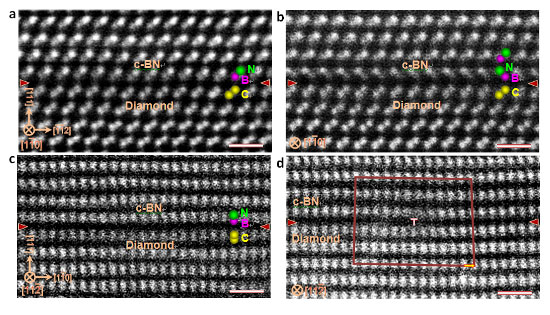| Posted: Apr 08, 2015 |
Atomic structure identified in coherent interfaces between superhard materials of diamond and boron nitride
|
|
(Nanowerk News) The research group led by Professor Yuichi Ikuhara (also appointed as a professor at Tokyo University), Associate Professor Zhongchang Wang and Assistant Professor Chunlin Chen at the Advanced Institute for Materials Research, Tohoku University (AIMR), in collaboration with Group Leader Takashi Taniguchi at the National Institute for Materials Science (NIMS) and Japan Fine Ceramics Center (JFCC), succeeded for the first time in identifying the atomic structure and bonding mechanism in coherent interfaces between diamond, the hardest known material, and cubic boron nitride, the second hardest, using a state-of-the-art super-high-resolution scanning transmission electron microscope and first-principles calculation.
|
 |
| (a and b) HAADF STEM images of c-BN/diamond interface viewed in direction parallel to [1-10] zone axis, (a) coherent area without defects, (b) area with defects, (c and d) HAADF STEM images of c-BN/diamond interface viewed in direction parallel to [11-2] zone axis, (c) area without defects, and (d) area with defects. Partial dislocations are observable. By comparing (c) and (d), a Burgers vector, which characterizes partial dislocations, of 1/4<1-10> was determined. All scale bars are 0.5 nm in length.
|
|
The research group has attempted to develop new functional materials by focusing on lattice defects in crystals, namely dislocation, grain boundaries and interfaces, analyzing their atomic structures, and controlling lattice defects. Through the concurrent use of atomic-resolution scanning transmission electron microscopy, for which technological breakthroughs were achieved in recent years, and extensive theoretical calculation based on first principles, the group revealed that in coherent interfaces between diamond and cubic boron nitride, carbon and boron are bonded to each other, and the type of crystal defect called dislocation has a characteristic structure.
|
|
In the future, these findings may be applicable to designing new devices using materials with improved properties resulting from controlling the formation of such defect structures, designing new devices incorporating lattice defect structures, and research and development of novel functional materials. This study was published in the online version of the UK scientific journal Nature Communications ("Misfit accommodation mechanism at the heterointerface between diamond and cubic boron nitride").
|

